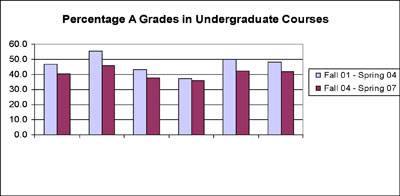Following the Monday, Sept. 17, faculty meeting, Dean of the College Nancy Malkiel issued the following statement on behalf of the Faculty Committee on Grading regarding grading results for 2006-07:
The Faculty Committee on Grading today announced the results of the first three years of implementation of Princeton's new grading policy. "The Princeton faculty has now demonstrated conclusively that with clear intent and concerted effort, a university faculty can bring down the inflated grades that -- left uncontrolled -- devalue the educational achievements of American college students," the committee said. "The Princeton faculty is working successfully to restore educational content and meaning to the letter grades earned by the highest-achieving students in the United States."
Princeton's new grading expectations, adopted by the faculty in April 2004, posit a common grading standard for every academic department and program, under which A's shall account for less than 35 percent of the grades given in undergraduate courses and less than 55 percent of the grades given in junior and senior independent work. The standard by which the grading record of a department or program will be evaluated is the percentage of A's given over the previous three years.
This report provides the first opportunity for the Grading Committee to compare three-year averages for grades given under the new grading policy (fall 2004-spring 2007) with grades given in the three years before the faculty adopted the new policy (fall 2001-spring 2004). In 2004-07, A's (A+, A, A-) accounted for 40.6 percent of grades in undergraduate courses, down from 47.0 percent in 2001-04. In humanities departments, A's accounted for 45.9 percent of the grades in undergraduate courses in 2004-07, down from 55.5 percent in 2001-04. In the social sciences, there were 37.6 percent A grades in 2004-07, down from 43.3 percent in the previous three years. In the natural sciences, there were 35.7 percent A grades in 2004-07, compared to 37.2 percent in 2001-04. In engineering, the figures were 42.1 percent A's in 2004-07, down from 50.2 percent in the previous three years.

"By any measure," the committee noted, "the faculty has achieved extremely impressive results. Even in the two divisions that are not yet in essential compliance, individual departments have made major strides in bringing their grades down."
Comparing the three-year averages for fall '04-spring '07 and fall '01-spring '04, with three exceptions, every department realized significant gains, and departments with the most ground to cover made the most progress. In five cases, departments reduced their percentage of A grades by as much as 15 percentage points; in 11 other cases, the reductions ranged from 8 to 11 percentage points. The three departments that saw no gains -- all in the natural sciences -- were already grading in accord with the policy.
The committee noted, also, that the marked shift in grading patterns has not led to an exodus of concentrators out of departments that are complying with the policy. At present, 63 percent of juniors and seniors are concentrating in departments that are at or very close to the desired standard for undergraduate courses, a fact that bears importantly on the faculty's aspiration that students should be graded evenhandedly across departments. In short, students are not avoiding departments that grade more rigorously; complying with the policy carries no penalty for departments with respect to numbers of concentrators.
"While there is clearly more work to be done in some departments," the Grading Committee said, "we continue to head in the right direction, and we are greatly encouraged by the progress made thus far. With another year of redoubled efforts on the part of the faculty, we will be closing in on our goal." The committee will be working with departments that still have work to do, both to understand better the challenges they are facing and to offer advice and assistance as they seek to achieve further progress.
This report speaks only to grades in undergraduate courses. The committee will report to the faculty about grades in independent work later in the academic year.
The Grading Committee reiterated its confidence in the educational benefits of the faculty's successful effort to bring grades under better control, and it reaffirmed its report last year that there have been no discernible negative effects of any kind on the fortunes of Princeton students in the various external marketplaces in which they compete for jobs and graduate and professional school admissions. Detailed data about employment and admissions will be included in a new pamphlet, Grading at Princeton: Frequently Asked Questions, which will be distributed later this month to all faculty, undergraduates and undergraduate parents.
The Faculty Committee on Grading consists of six elected faculty members: Christopher Achen, politics; Martha Himmelfarb, religion; Daniel Marlow, physics; Mark Rose, molecular biology; Jaswinder Pal Singh, computer science; and Kyle Vanderlick, chemical engineering. The dean of the faculty, the dean of the college and the registrar serve ex officio. The committee's charge from the faculty is to assess the progress made in implementing the new grading expectations and to advise on ways of making further progress.